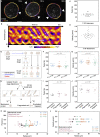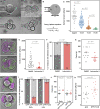Cortical softening elicits zygotic contractility during mouse preimplantation development
- PMID: 35324889
- PMCID: PMC8982894
- DOI: 10.1371/journal.pbio.3001593
Cortical softening elicits zygotic contractility during mouse preimplantation development
Abstract
Actomyosin contractility is a major engine of preimplantation morphogenesis, which starts at the 8-cell stage during mouse embryonic development. Contractility becomes first visible with the appearance of periodic cortical waves of contraction (PeCoWaCo), which travel around blastomeres in an oscillatory fashion. How contractility of the mouse embryo becomes active remains unknown. We have taken advantage of PeCoWaCo to study the awakening of contractility during preimplantation development. We find that PeCoWaCo become detectable in most embryos only after the second cleavage and gradually increase their oscillation frequency with each successive cleavage. To test the influence of cell size reduction during cleavage divisions, we use cell fusion and fragmentation to manipulate cell size across a 20- to 60-μm range. We find that the stepwise reduction in cell size caused by cleavage divisions does not explain the presence of PeCoWaCo or their accelerating rhythm. Instead, we discover that blastomeres gradually decrease their surface tensions until the 8-cell stage and that artificially softening cells enhances PeCoWaCo prematurely. We further identify the programmed down-regulation of the formin Fmnl3 as a required event to soften the cortex and expose PeCoWaCo. Therefore, during cleavage stages, cortical softening, mediated by Fmnl3 down-regulation, awakens zygotic contractility before preimplantation morphogenesis.
Conflict of interest statement
The authors have declared that no competing interests exist.
Figures




Similar articles
-
Retrospective analysis: reproducibility of interblastomere differences of mRNA expression in 2-cell stage mouse embryos is remarkably poor due to combinatorial mechanisms of blastomere diversification.Mol Hum Reprod. 2018 Jul 1;24(7):388-400. doi: 10.1093/molehr/gay021. Mol Hum Reprod. 2018. PMID: 29746690
-
Multiscale morphogenesis of the mouse blastocyst by actomyosin contractility.Curr Opin Cell Biol. 2020 Oct;66:123-129. doi: 10.1016/j.ceb.2020.05.002. Epub 2020 Jul 22. Curr Opin Cell Biol. 2020. PMID: 32711300 Review.
-
Multiscale analysis of single and double maternal-zygotic Myh9 and Myh10 mutants during mouse preimplantation development.Elife. 2021 Apr 19;10:e68536. doi: 10.7554/eLife.68536. Elife. 2021. PMID: 33871354 Free PMC article.
-
WNT4-like protein is a cortical granule component in mouse oocytes and functions in regulating preimplantation embryogenesis.Syst Biol Reprod Med. 2016;62(1):49-56. doi: 10.3109/19396368.2015.1112445. Epub 2015 Dec 23. Syst Biol Reprod Med. 2016. PMID: 26700598
-
Sequential comprehensive chromosome analysis on polar bodies, blastomeres and trophoblast: insights into female meiotic errors and chromosomal segregation in the preimplantation window of embryo development.Hum Reprod. 2013 Feb;28(2):509-18. doi: 10.1093/humrep/des394. Epub 2012 Nov 11. Hum Reprod. 2013. PMID: 23148203
Cited by
-
Competition and synergy of Arp2/3 and formins in nucleating actin waves.Cell Rep. 2024 Jul 23;43(7):114423. doi: 10.1016/j.celrep.2024.114423. Epub 2024 Jul 4. Cell Rep. 2024. PMID: 38968072 Free PMC article.
-
Inverse bleb membrane protrusions pump fluid within the early mouse embryo.Nat Cell Biol. 2024 Oct;26(10):1637-1638. doi: 10.1038/s41556-024-01510-y. Nat Cell Biol. 2024. PMID: 39304714 No abstract available.
-
Ezrin expression in female reproductive tissues: A review of regulation and pathophysiological implications.Front Cell Dev Biol. 2023 Mar 8;11:1125881. doi: 10.3389/fcell.2023.1125881. eCollection 2023. Front Cell Dev Biol. 2023. PMID: 36968198 Free PMC article. Review.
-
Mechanics of human embryo compaction.Nature. 2024 May;629(8012):646-651. doi: 10.1038/s41586-024-07351-x. Epub 2024 May 1. Nature. 2024. PMID: 38693259
-
How great thou ART: biomechanical properties of oocytes and embryos as indicators of quality in assisted reproductive technologies.Front Cell Dev Biol. 2024 Feb 15;12:1342905. doi: 10.3389/fcell.2024.1342905. eCollection 2024. Front Cell Dev Biol. 2024. PMID: 38425501 Free PMC article. Review.
References
Publication types
MeSH terms
LinkOut - more resources
Full Text Sources

